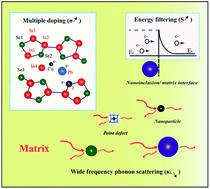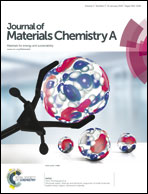Multiple heteroatom induced carrier engineering and hierarchical nanostructures for high thermoelectric performance of polycrystalline In4Se2.5†
Abstract
In this paper, different atom combinations of Pb, I and Cu have been doped into the In4Se2.5 matrix and a systematic investigation has been carried out for the synergistic effect of multiple heteroatoms on the microstructure and thermoelectric properties of polycrystalline In4Se2.5. By this approach, the electron and phonon transport properties are rationally regulated and the electrical conductivity increases greatly due to the multiple doping, which result in a simultaneous increase of carrier concentration and mobility. The Seebeck coefficient also remains at a relatively high level in a high temperature range due to the energy-dependent electron scattering at the metal nanoparticle–matrix interfaces. In addition, the lattice thermal conductivity is also greatly reduced because of the wide frequency phonon scattering by the point defects and hierarchical metal nanoparticles combined with the phonon–phonon interactions. Consequently, an enhancement of the ZT with a maximum of 1.4 (723 K) has been achieved in the multiple doped In4Se2.5 sample.


 Please wait while we load your content...
Please wait while we load your content...